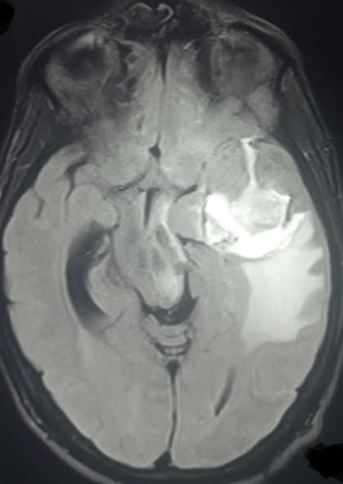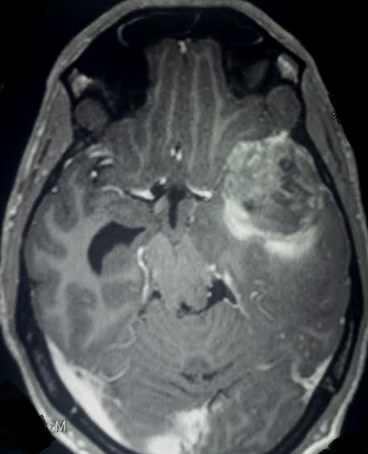[1]
Kar SK, Das A, Pandey S, Gupta B. Kluver-Bucy Syndrome in an Adolescent Girl: A Sequel of Encephalitis. Journal of pediatric neurosciences. 2018 Oct-Dec:13(4):523-524. doi: 10.4103/JPN.JPN_70_18. Epub
[PubMed PMID: 30937109]
[2]
Jha KK, Singh SK, Kumar P, Arora CD. Partial Kluver-Bucy syndrome secondary to tubercular meningitis. BMJ case reports. 2016 Aug 16:2016():. doi: 10.1136/bcr-2016-215926. Epub 2016 Aug 16
[PubMed PMID: 27530874]
Level 3 (low-level) evidence
[3]
Rieder HL,Snider DE Jr,Cauthen GM, Extrapulmonary tuberculosis in the United States. The American review of respiratory disease. 1990 Feb;
[PubMed PMID: 2301852]
[4]
Vannemreddy PSSV, Stone JL. Sanger Brown and Edward Schäfer before Heinrich Klüver and Paul Bucy: their observations on bilateral temporal lobe ablations. Neurosurgical focus. 2017 Sep:43(3):E2. doi: 10.3171/2017.6.FOCUS17265. Epub
[PubMed PMID: 28859570]
[5]
Klüver H, Bucy PC. Preliminary analysis of functions of the temporal lobes in monkeys. 1939. The Journal of neuropsychiatry and clinical neurosciences. 1997 Fall:9(4):606-20
[PubMed PMID: 9447506]
[6]
TERZIAN H, ORE GD. Syndrome of Klüver and Bucy; reproduced in man by bilateral removal of the temporal lobes. Neurology. 1955 Jun:5(6):373-80
[PubMed PMID: 14383941]
[7]
Brigo F. Hrayr Terzian (1925-1988): a life between experimental neurophysiology and clinical neurology. Neurological sciences : official journal of the Italian Neurological Society and of the Italian Society of Clinical Neurophysiology. 2021 Sep:42(9):3939-3942. doi: 10.1007/s10072-021-05070-z. Epub 2021 Jan 26
[PubMed PMID: 33495930]
[8]
Marlowe WB, Mancall EL, Thomas JJ. Complete Klüver-Bucy syndrome in man. Cortex; a journal devoted to the study of the nervous system and behavior. 1975 Mar:11(1):53-9
[PubMed PMID: 168031]
[9]
Eikmeier G, Forquignon I, Honig H. [Klüver-Bucy syndrome after herpes simplex encephalitis]. Psychiatrische Praxis. 2013 Oct:40(7):392-3. doi: 10.1055/s-0033-1343274. Epub 2013 Jul 11
[PubMed PMID: 23846508]
[10]
Chou CL, Lin YJ, Sheu YL, Lin CJ, Hseuh IH. Persistent Klüver-Bucy syndrome after bilateral temporal lobe infarction. Acta neurologica Taiwanica. 2008 Sep:17(3):199-202
[PubMed PMID: 18975528]
[11]
Ozdemir H, Rezaki M. [Klüver-Bucy-like syndrome and frontal symptoms following cerebrovascular disease]. Turk psikiyatri dergisi = Turkish journal of psychiatry. 2007 Summer:18(2):184-8
[PubMed PMID: 17566885]
[12]
Cohen MJ, Park YD, Kim H, Pillai JJ. Long-term neuropsychological follow-up of a child with Klüver-Bucy syndrome. Epilepsy & behavior : E&B. 2010 Dec:19(4):643-6. doi: 10.1016/j.yebeh.2010.09.003. Epub
[PubMed PMID: 20926352]
[13]
Morcos N, Guirgis H. A case of acute-onset partial Kluver-Bucy syndrome in a patient with a history of traumatic brain injury. The Journal of neuropsychiatry and clinical neurosciences. 2014 Summer:26(3):E10-1. doi: 10.1176/appi.neuropsych.13060132. Epub
[PubMed PMID: 25093767]
Level 3 (low-level) evidence
[14]
Leesch W, Fischer I, Staudinger R, Miller DC, Sathe S. Primary cerebral Whipple disease presenting as Klüver-Bucy syndrome. Archives of neurology. 2009 Jan:66(1):130-1. doi: 10.1001/archneurol.2008.531. Epub
[PubMed PMID: 19139312]
[15]
Kile SJ, Ellis WG, Olichney JM, Farias S, DeCarli C. Alzheimer abnormalities of the amygdala with Klüver-Bucy syndrome symptoms: an amygdaloid variant of Alzheimer disease. Archives of neurology. 2009 Jan:66(1):125-9. doi: 10.1001/archneurol.2008.517. Epub
[PubMed PMID: 19139311]
[16]
Cummings JL, Duchen LW. Kluver-Bucy syndrome in Pick disease: clinical and pathologic correlations. Neurology. 1981 Nov:31(11):1415-22
[PubMed PMID: 7198189]
[17]
Boudjemline AM, Isapof A, Witas JB, Petit FM, Gajdos V, Labrune P. Klüver Bucy syndrome following hypoglycaemic coma in a patient with glycogen storage disease type Ib. Journal of inherited metabolic disease. 2010 Dec:33 Suppl 3():S477-80. doi: 10.1007/s10545-010-9243-y. Epub 2010 Nov 20
[PubMed PMID: 21103936]
[18]
Guidotti TL, Charness ME, Lamon JM. Acute intermittent porphyria and the Klüver -- Bucy syndrome. The Johns Hopkins medical journal. 1979 Dec:145(6):233-5
[PubMed PMID: 513431]
[19]
Janati A. Kluver-Bucy syndrome in Huntington's chorea. The Journal of nervous and mental disease. 1985 Oct:173(10):632-5
[PubMed PMID: 3161995]
[20]
Lanska DJ, Lanska MJ. Klüver-Bucy syndrome in juvenile neuronal ceroid lipofuscinosis. Journal of child neurology. 1994 Jan:9(1):67-9
[PubMed PMID: 8151088]
[21]
Naito K, Hashimoto T, Ikeda S. Klüver-Bucy syndrome following status epilepticus associated with hepatic encephalopathy. Epilepsy & behavior : E&B. 2008 Feb:12(2):337-9
[PubMed PMID: 17980671]
[22]
Pitt DC, Kriel RL, Wagner NC, Krach LE. Kluver-Bucy syndrome following heat stroke in a 12-year-old girl. Pediatric neurology. 1995 Jul:13(1):73-6
[PubMed PMID: 7575855]
[23]
Guedalia JS, Zlotogorski Z, Goren A, Steinberg A. A reversible case of Klüver-Bucy syndrome in association with shigellosis. Journal of child neurology. 1993 Oct:8(4):313-5
[PubMed PMID: 8228026]
Level 3 (low-level) evidence
[24]
Samanta D. Transient Kluver-Bucy syndrome from methamphetamine withdrawal. Neurology India. 2015 Mar-Apr:63(2):267-8. doi: 10.4103/0028-3886.156304. Epub
[PubMed PMID: 25948002]
[25]
Lin HF, Yeh YC, Chen CF, Chang WC, Chen CS. Kluver-Bucy syndrome in one case with systemic lupus erythematosus. The Kaohsiung journal of medical sciences. 2011 Apr:27(4):159-62. doi: 10.1016/j.kjms.2010.12.011. Epub 2011 Feb 17
[PubMed PMID: 21463840]
Level 3 (low-level) evidence
[26]
Jha S, Patel R. Kluver-Bucy syndrome -- an experience with six cases. Neurology India. 2004 Sep:52(3):369-71
[PubMed PMID: 15472430]
Level 3 (low-level) evidence
[27]
Unal E, Koksal Y, Baysal T, Energin Ml, Aydin K, Caliskan U. Kluver-Bucy syndrome in a boy with non-Hodgkin lymphoma. Pediatric hematology and oncology. 2007 Mar:24(2):149-52
[PubMed PMID: 17454782]
[28]
Auvichayapat N, Auvichayapat P, Watanatorn J, Thamaroj J, Jitpimolmard S. Kluver-Bucy syndrome after mycoplasmal bronchitis. Epilepsy & behavior : E&B. 2006 Feb:8(1):320-2
[PubMed PMID: 16356778]
[29]
Antunes NL, Souweidane MM, Lis E, Rosenblum MK, Steinherz PG. Methotrexate leukoencephalopathy presenting as Klüver-Bucy syndrome and uncinate seizures. Pediatric neurology. 2002 Apr:26(4):305-8
[PubMed PMID: 11992760]
[30]
Duggal HS, Khess CR, Nizamie SH. Subdural hygroma presenting as dementia with kluver-bucy symptoms. Indian journal of psychiatry. 1999 Oct:41(4):371-3
[PubMed PMID: 21430814]
[31]
Ruiz-García RG, Chacón-González J, Bayliss L, Ramírez-Bermúdez J. Neuropsychiatry of Susac Syndrome: a Case Report. Revista Colombiana de psiquiatria (English ed.). 2021 Apr-Jun:50(2):146-151. doi: 10.1016/j.rcp.2019.10.007. Epub 2020 Feb 7
[PubMed PMID: 33735032]
Level 3 (low-level) evidence
[32]
Soni V, Sharawat IK, Kasinathan A, Saini L, Suthar R. Kluver-Bucy syndrome in a girl with anti-NMDAR encephalitis. Neurology India. 2019 May-Jun:67(3):887-889. doi: 10.4103/0028-3886.263181. Epub
[PubMed PMID: 31347577]
[33]
Raju VV, Sankhyan N, Padhy SK. A Single Exposure to Cannabis Presenting with Klüver-Bucy Syndrome in a Child: A Rare Case Report. Indian journal of pediatrics. 2022 Feb:89(2):208. doi: 10.1007/s12098-021-03997-x. Epub 2021 Nov 6
[PubMed PMID: 34741255]
Level 3 (low-level) evidence
[34]
Lanska DJ. The Klüver-Bucy Syndrome. Frontiers of neurology and neuroscience. 2018:41():77-89. doi: 10.1159/000475721. Epub 2017 Nov 16
[PubMed PMID: 29145186]
[35]
Olson DA. Klüver-Bucy syndrome as a result of minor head trauma. Southern medical journal. 2003 Mar:96(3):323
[PubMed PMID: 12659375]
[36]
Geschwind N. Disconnexion syndromes in animals and man: Part I. 1965. Neuropsychology review. 2010 Jun:20(2):128-57
[PubMed PMID: 20540177]
Level 3 (low-level) evidence
[37]
Müller A, Baumgartner RW, Röhrenbach C, Regard M. Persistent Klüver-Bucy syndrome after bilateral thalamic infarction. Neuropsychiatry, neuropsychology, and behavioral neurology. 1999 Apr:12(2):136-9
[PubMed PMID: 10223262]
[38]
Rajmohan V, Mohandas E. The limbic system. Indian journal of psychiatry. 2007 Apr:49(2):132-9. doi: 10.4103/0019-5545.33264. Epub
[PubMed PMID: 20711399]
[39]
von Wild K, Laureys ST, Gerstenbrand F, Dolce G, Onose G. The vegetative state--a syndrome in search of a name. Journal of medicine and life. 2012 Feb 22:5(1):3-15
[PubMed PMID: 22574081]
[40]
Hooshmand H, Sepdham T, Vries JK. Klüver-Bucy syndrome. Successful treatment with carbamazepine. JAMA. 1974 Sep 23:229(13):1782
[PubMed PMID: 4479148]
[41]
Clay FJ, Kuriakose A, Lesche D, Hicks AJ, Zaman H, Azizi E, Ponsford JL, Jayaram M, Hopwood M. Klüver-Bucy Syndrome Following Traumatic Brain Injury: A Systematic Synthesis and Review of Pharmacological Treatment From Cases in Adolescents and Adults. The Journal of neuropsychiatry and clinical neurosciences. 2019 Winter:31(1):6-16. doi: 10.1176/appi.neuropsych.18050112. Epub 2018 Oct 31
[PubMed PMID: 30376788]
Level 3 (low-level) evidence


